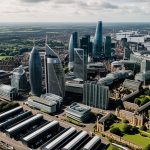Key Forecasts Shaping the Future of UK Women’s Fashion
The UK women’s fashion trends for the coming years reveal a dynamic shift influenced heavily by both consumer behaviors and industry innovation. Fashion industry forecasts indicate a move toward versatility and sustainability, reflecting changing lifestyle demands. London Fashion Week remains a crucial platform, showcasing cutting-edge designs that blend bold creativity with practical wearability. Expert analysis highlights the rise of gender-fluid elements and retro-inspired aesthetics, signaling a broadening definition of style.
Consumer habits play a pivotal role in shaping these trends. The increasing preference for ethically produced garments and eco-conscious choices drives brands to innovate in materials and production methods. Additionally, data points to a growing appetite for personalized, statement pieces that convey individual identity rather than mass-market conformity.
This might interest you : Why Are Sustainable Fashion Practices the Future of UK Women’s Apparel?
Importantly, fashion industry forecasts suggest that UK women will prioritize comfort without compromising style, favoring pieces adaptable across occasions. The synergy of these factors positions the UK fashion scene as both progressive and deeply responsive to societal shifts, forecasting an exciting and inclusive evolution in women’s wardrobes.
Emerging Styles and Silhouettes in UK Women’s Fashion
The future fashion silhouettes in UK women’s fashion trends reveal a strong inclination toward fluidity and experimental cuts. Experts emphasize that oversized shapes and asymmetrical hems will dominate, blending comfort with drama. London Fashion Week has showcased these evolving styles, where designers merge avant-garde elements with wearable forms—signaling a shift toward expressive yet adaptable pieces.
This might interest you : Why Are Sustainable Fashion Practices the Future of UK Women’s Apparel?
High fashion’s innovation is echoed by British high street brands, which are adopting these shapes in a more accessible way. The balance between statement pieces and everyday functionality defines these new looks, with layering and mixed textures becoming key techniques.
Among the trending styles, structured shoulders paired with relaxed fits offer contrast and confidence. Additionally, tailored wide-leg trousers and midi dresses with bold hemlines provide versatility across occasions. This evolution aligns closely with consumer desires for individuality and practicality, as reported in fashion industry forecasts.
Anticipating these silhouettes helps brands meet demand while encouraging women to explore fresh, empowering outfits that reflect today’s diverse lifestyle.
Colour Palettes and Fabric Choices for the Upcoming Seasons
The trend colours predicted for upcoming UK women’s fashion seasons prominently feature muted earth tones alongside vibrant jewel shades. Pantone’s latest releases and UK runway trends emphasize warm rusts, deep emeralds, and soft terracotta, reflecting a balance between natural inspiration and bold expression. Seasonal materials in the UK are leaning toward versatility, with designers favoring fabrics that perform well across variable climates.
Sustainable fabrics are at the forefront of fashion industry forecasts. Natural fibres like organic cotton and linen are gaining traction due to their low environmental impact. Additionally, recycled materials such as regenerated nylon and polyester innovate sustainable manufacturing while maintaining quality. This shift responds to consumer demands for ethical choices without compromising style or comfort.
Climate change and evolving cultural tastes heavily influence fabric and colour decisions. Cooler summers and unpredictable weather promote layered, adaptable clothing crafted from breathable yet durable textiles. Simultaneously, cultural trends in the UK inspire a return to artisan techniques and locally sourced materials, enhancing both sustainability and the uniqueness of each collection. These fabric and colour preferences vividly illustrate a future intertwining eco-awareness with aesthetic appeal.
Key Forecasts Shaping the Future of UK Women’s Fashion
Fashion industry forecasts underscore a strong momentum toward sustainability, technological integration, and personalized style in UK women’s fashion trends. London Fashion Week remains a vital influencer, unveiling collections that blend innovative materials with adaptive designs. Expert analysis highlights that future style predictions will increasingly favor garments that balance eco-conscious production with comfort and versatility.
Consumer behavior shifts, particularly among younger demographics, drive brands to focus on ethical manufacturing and inclusivity. Data shows a rising demand for transparency and local craftsmanship, positioning these elements as critical in upcoming fashion cycles. Digital innovation also plays a growing role, with consumers engaging through virtual platforms that influence trend adoption and enhance personalization.
The forecasted trends indicate a fusion of classic aesthetics with modern needs—embracing fluidity in style and function. This aligns with a broader cultural move toward diversity and expression, encouraging UK women to adopt fashion that reflects individual identity while responding to environmental and social considerations. Overall, the future of UK women’s fashion is poised for transformation that is purposeful, stylish, and reflective of evolving consumer values.
Key Forecasts Shaping the Future of UK Women’s Fashion
The future style predictions for UK women’s fashion reveal a clear trajectory shaped by in-depth fashion industry forecasts. These forecasts emphasize a synthesis of sustainability, versatility, and personalized expression as driving forces of change. London Fashion Week exerts a leading influence, consistently introducing innovative designs that blend forward-thinking aesthetics with practicality, setting the tone for the wider market.
Consumer behaviour is notably shifting, with an increasing demand for transparency and ethical production methods. This change directs brands to craft collections balancing style with social responsibility. Data from the industry further highlights the rising appeal of garments that adapt across various contexts, responding to the modern woman’s evolving lifestyle needs.
Expert analysis stresses that UK women’s fashion trends will continue to embrace fluid silhouettes, dynamic colour palettes, and multifunctional pieces. This trend underscores a move away from fast fashion toward mindful consumption. The integration of technology, including virtual platforms, supports personalized shopping experiences, fueling a more engaged and informed consumer base. The confluence of these factors provides a robust outlook anchoring UK women’s fashion firmly in the future-focused, ethical, and innovative realm.






